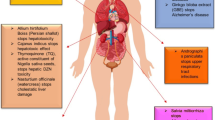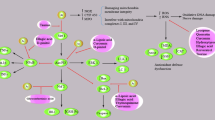Abstract
Free radicals are reactive species that are responsible for damaging normal cells and creating diseases in humans. Antioxidants from natural resources or as supplements can scavenge these radicals. A MedLine search indicates that vitamin C is the most investigated antioxidant responsible for the elimination of free radicals. Its chelating property for the removal of neurotoxic lead, which creates oxidative stress in the human biosystem, was investigated and results indicate its great potential as a lead-detoxifying agent.

Similar content being viewed by others
References
Schindler, T. H., Nitzsche, E. U., Munzel, T., Olschewski, M., Brink, I., Jeserich, M., Mix, M., Buser, P. T., Pfisterer, M., Solzbach, U., & Just, H. (2003). Coronary vasoregulation in patients with various risk factors in response to cold pressor testing: Contrasting myocardial blood flow responses to short- and long-term vitamin C administration. Journal of the American College of Cardiology, 42(5), 814–822.
Chade, A. R., Rodriguez-Porcel, M., Herrmann, J., Krier, J. D., Zhu, X., Lerman, A., & Lerman, L. O. (2003). Beneficial effects of antioxidant vitamins on the stenotic kidney. Hypertension, 42(4), 605–612.
Behrendt, D., Beltrame, J., Hikiti, H., Wainstein, M., Kinlay, S., Selwyn, A. P., Ganz, P., & Fang, J. C. (2006). Impact of coronary endothelial function on the progression of cardiac transplant-associated arteriosclerosis: Effect of anti-oxidant vitamins C and E. The Journal of Heart and Lung Transplantation, 25(4), 426–433.
Antoniades, C., Tousoulis, D., Tentolouris, C., Toutouza, M., Marinou, K., Goumas, G., Tsioufis, C., Toutouzas, P., & Stefanadis, C. (2003). Effects of antioxidant vitamins C and E on endothelial function and thrombosis/fibrinolysis system in smokers. Thrombosis and Haemostasis, 89(6), 990–995.
Neri, S., Signorelli, S. S., Torrisi, B., Pulvirenti, D., Mauceri, B., Abate, G., Ignaccolo, L., Bordonaro, F., Cilio, D., Calvagno, S., & Leotta, C. (2005). Effects of antioxidant supplementation on postprandial oxidative stress and endothelial dysfunction: A single-blind, 15-day clinical trial in patients with untreated type 2 diabetes, subjects with impaired glucose tolerance, and healthy controls. Clinical Therapeutics, 7(11), 1764–1773.
Chade, A. R., Krier, J. D., Rodriguez-Porcel, M., Breen, J. F., McKusick, M. A., Lerman, A., & Lerman, L. O. (2004). Comparison of acute and chronic antioxidant interventions in experimental renovascular disease. American Journal of Physiology. Renal Physiology, 286(6), F1079–1086.
Richartz, B. M., Werner, G. S., Ferrari, M., & Figulla, H. R. (2001). Reversibility of coronary endothelial vasomotor dysfunction in idiopathic dilated cardiomyopathy: acute effects of vitamin C. The American Journal of Cardiology, 88(9), 1001–1005.
Sato, M., Matsumoto, Y., Morita, H., Takemura, H., Shimoi, K., & Amano, I. (2003). Effects of vitamin supplementation on microcirculatory disturbance in hemodialysis patients without peripheral arterial disease. Clinical Nephrology, 60(1), 28–34.
Ellis, G. R., Anderson, R. A., Chirkov, Y. Y., Morris-Thurgood, J., Jackson, S. K., Lewis, M. J., Horowitz, J. D., & Frenneaux, M. P. (2001). Acute effects of vitamin C on platelet responsiveness to nitric oxide donors and endothelial function in patients with chronic heart failure. Journal of Cardiovascular Pharmacology, 37(5), 564–570.
Takase, B., Etsuda, H., Matsushima, Y., Ayaori, M., Kusano, H., Hamabe, A., Uehata, A., Ohsuzu, F., Ishihara, M., & Kurita, A. (2004). Effect of chronic oral supplementation with vitamins on the endothelial function in chronic smokers. Angiology, 55(6), 653–660.
Versari, D., Herrmann, J., Gossl, M., Mannheim, D., Sattler, K., Meyer, F. B., Lerman, L. O., & Lerman, A. (2006). Chronic antioxidant supplementation impairs coronary endothelial function and myocardial perfusion in normal pigs. Hypertension, 47(3), 475–481.
Rodriguez-Porcel, M., Herrman, J., Chade, A. R., Krier, J. D., Breen, J. F., Lerman, A., & Lerman, L. O. (2004). Long-term antioxidant intervention improves myocardial microvascular function in experimental hypertension. Hypertension, 43(2), 493–498.
Zhu, X. Y., Rodriguez-Porcel, M., Bentley, M. D., Chade, A. R., Sica, V., Napoli, C., Caplice, N., Ritman, E. L., Lerman, A., & Lerman, L. O. (2004). Antioxidant intervention attenuates myocardial neovascularization in hypercholesterolemia. Circulation, 109(17), 2109–2115.
Ulker, S., McMaster, D., McKeown, P. P., & Bayraktutan, U. (2004). Antioxidant vitamins C and E ameliorate hyperglycaemia-induced oxidative stress in coronary endothelial cells. Diabetes, Obesity & Metabolism, 6(6), 442–451.
Stulak, J. M., Lerman, A., Porcel, M. R., Caccitolo, J. A., Romero, J. C., Schaff, H. V., Napoli, C., & Lerman, L. O. (2001). Renal vascular function in hypercholesterolemia is preserved by chronic antioxidant supplementation. Journal of the American Society of Nephrology, 12(9), 1882–1891.
Kinlay, S., Behrendt, D., Fang, J. C., Delagrange, D., Morrow, J., Witztum, J. L, Rifai, N., Selwyn, A. P., Creager, M. A., & Ganz, P. (2004). Long-term effect of combined vitamins E and C on coronary and peripheral endothelial function. Journal of the American College of Cardiology, 43(4), 629–634.
Tam, L. S., Li, E. K., Leung, V. Y., Griffith, J. F., Benzie, I. F., Lim, P. L., Whitney, B., Lee, V. W., Lee, K. K., Thomas, G. N., & Tomlinson, B. (2005). Effects of vitamins C and E on oxidative stress markers and endothelial function in patients with systemic lupus erythematosus: A double blind, placebo controlled pilot study. The Journal of Rheumatology, 32(2), 275–282.
McKechnie, R., Rubenfire, M., & Mosca, L. (2002). Antioxidant nutrient supplementation and brachial reactivity in patients with coronary artery disease. The Journal of Laboratory and Clinical Medicine, 139(3), 133–139.
Raitakari, O. T., Adams, M. R., McCredie, R. J., Griffiths, K. A., Stocker, R., & Celermajer, D. S. (2000). Oral vitamin C and endothelial function in smokers: Short-term improvement, but no sustained beneficial effect. Journal of the American College of Cardiology, 35(6), 1616–1621.
Alper, G., Olukman, M., Irer, S., Caglayan, O., Duman, E., Yilmaz, C., & Ulker, S. (2006). Effect of vitamin E and C supplementation combined with oral antidiabetic therapy on the endothelial dysfunction in the neonatally streptozotocin injected diabetic rat. Diabetes/Metabolism Research and Reviews, 22(3), 190–197.
Cathcart, R. F. (1981). The method of determining proper doses of vitamin C for the treatment of diseases by titrating to bowel tolerance. Journal of Orthomolecular Psychiatry, 10, 125–133.
Rahbar, M.H., White, F., Agboatwalla, M., Hozhabri, S., & Luby, S. (2002). Factors associated with elevated blood lead concentrations in children in Karachi, Pakistan. Bulletin of the World Health Organization, 80(10), 769–775.
Hozharbi, S. (2002). Lead-based paint is a hazard to young children: Implications for Pakistani children. Journal of the Pakistan Medical Association, 52(5), 224–226.
Khan, A. H., Khan, A., Ghani, F., & Khurshid, M. (2001). Low-level lead exposure and blood lead levels in children: A cross-sectional survey. Archives of Environmental Health, 56(6), 501–505.
Rahman, A., & Yousuf, F.A. (2002). Lead levels in primary teeth of children in Karachi. Annals of Tropical Paediatrics, 22(1), 79–83.
White, F., Rahbar, M. H., Agboatwalla, M., Luby, S., Iqbal A., & Hozhabri, S. (2001). Elevated blood lead levels in Karachi children. Bulletin of the World Health Organization, 79(2), 173.
Tarion, R. (1999). The effect of vitamin C supplementation on lead levels in children. B.Sc. (Honours) Thesis, Universiti Malaysia Sabah, Malaysia.
Ahmad, Z. (2001). The effect of vitamin C supplementation on lead levels in Ranau and Papar school children. B.Sc. (Honours) Thesis, Universiti Malaysia Sabah, Malaysia.
Gilani, A. H., Tariq, S. A., Shah, A. J.,. Zaidi, S. A. H., Butt, Z. A., & Ghayur, M. N. (2003). Effect of vitamin C supplementation on body lead in children. Proceedings of the Summer Meeting The British Pharmacological Society, University of Surrey, June, 11/24.
Joel, A., Simon, J. A., & Esther, S. (1999). Relationship of ascorbic acid to blood lead levels. The Journal of the American Medical Association, 281, 2289–2293.
Houston, D. K., & Johnson, M. A. (2000). Does vitamin C intake protect against lead toxicity? Nutrition Reviews, 58(3 Pt 1), 73–75.
Tandon, S. K., Chatterjee, M., Bhargava, A., Shukla, V., & Bihari, V. (2001). Lead poisoning in Indian silver refiners. The Science of the Total Environment, 281(1–3), 177–182.
Acknowledgments
(A) Sabah State Government for funding and School of Science and Technology, Universiti Malaysia Sabah, Malaysia for the research facilities to: (1) Raidi Tarion (1998–1999) and (2) Zarina Binti Ahmad (2000–2001). (B) UNDP (Pakistan) for funding and Aga Khan University Medical College for facilities (2003).
Author information
Authors and Affiliations
Corresponding author
Rights and permissions
About this article
Cite this article
Tariq, S.A. Role of Ascorbic Acid in Scavenging Free Radicals and Lead Toxicity from Biosystems. Mol Biotechnol 37, 62–65 (2007). https://doi.org/10.1007/s12033-007-0045-x
Published:
Issue Date:
DOI: https://doi.org/10.1007/s12033-007-0045-x




